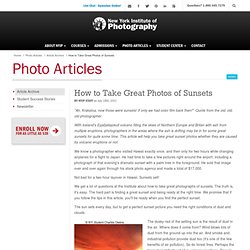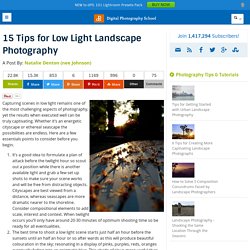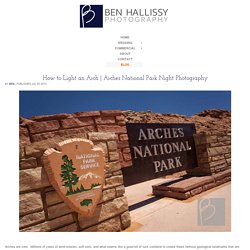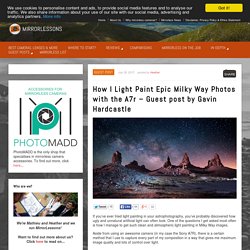

How to Photograph the Milky Way + 2021 Viewing Calendar! A good starting point to photographing the Milky Way is: aperture f/2.8 or the widest in your lens, ISO 3200-6400, and a shutter speed between 10-25 seconds depending on your focal length to capture sharp stars.

The longer the focal length, the faster your shutter speed should be. However, photographing the Milky Way is more complex than adjusting a few settings. I found my first Milky Way photography sessions very challenging, and it took me years until I could master the best steps and settings to shoot our galaxy. Sunset Photography: Tips to Get Amazing Sunset Photos - PhotoJeepers. Sharing is caring!

Photos taken at sunset capture the soft, diffused light that happens as the sun sets. The Golden Hour light, approximately 30-60 minutes before sunset, is a warm golden glow that produces long, soft shadows. After the sun disappears behind the horizon, the Golden Hour transforms into the Blue Hour. The characteristics of the Blue Hour are a much darker sky and soft blue hues. Sunset photography produces different visual effects in a very short period of time because the quality of light constantly changes. But, it’s also a tricky and complex time to take photos. We share our sunset photography tips so you can get amazing sunset photos. Consent Form. Sunset Photography. "Ah, Krakatoa, now those were sunsets!

If only we had color film back then! " -Quote from the old, old, old photographer. With Iceland's Eyjafjallajokull volcano filling the skies of Northern Europe and Britan with ash from multiple eruptions, photographers in the areas where the ash is drifting may be in for some great sunsets for quite some time. This article will help you take great sunset photos whether they are caused by volcanic eruptions or not.
We know a photographer who visited Hawaii exactly once, and then only for two hours while changing airplanes for a flight to Japan. Not bad for a two-hour layover in Hawaii. We get a lot of questions at the Institute about how to take great photographs of sunsets. The sun sets every day, but to get a perfect sunset picture you need the right conditions of dust and clouds. The dusky-red of the setting sun is the result of dust in the air. Clouds help too. 15 Tips for Low Light Landscape Photography. A Post By: Natalie Denton (nee Johnson) Capturing scenes in low light remains one of the most challenging aspects of photography, yet the results when executed well can be truly captivating.

Whether it’s an energetic cityscape or ethereal seascape the possibilities are endless. Here are a few essentials points to consider before you begin. It’s a good idea to formulate a plan of attack before the twilight hour so scout out a position while there is another available light and grab a few set up shots to make sure your scene works and will be free from distracting objects. Cityscapes are best viewed from a distance, whereas seascapes are more dramatic nearer to the shoreline. Image by V31S70 So start by setting your camera upon a solid tripod and switching the unit to manual or shutter priority if you are wish. Image by kern.justin Image by Paco CT Incorporate a foreground element to add interest, scale and to help contextualise the piece.
Arches National Park Night Photography. Arches are cool.

Millions of years of wind erosion, soft rock, and what seems like a good bit of luck combine to create these famous geological landmarks that are literally one of a kind. Some of the most famous sandstone arches in the world are contained within Arches National Park, and I recently got the chance to travel out west to explore that area with two of my good friends, Mike and David (see this post for background). For a post about Arches NP, I thought I’d change it up with a step-by-step look at how some of the night photos (or wide-field astrophotography) happened.
At times this post will devolve into photo-nerd-speak, so if your eyes glaze over when that happens, try less reading and more looking at pictures The arch you see above (which also happens to be on Utah’s license plate, so it’s clearly cool) is called Delicate Arch. Double arch is another popular feature, and it was there (around midnight) we experimented with a variety of night-lighting styles. How I Light Paint Epic Milky Way Photos with the A7r. If you’ve ever tried light painting in your astrophotography, you’ve probably discovered how ugly and unnatural artificial light can often look.

One of the questions I get asked most often is how I manage to get such clean and atmospheric light painting in Milky Way images. Aside from using an awesome camera (in my case the Sony A7R), there is a certain method that I use to capture every part of my composition in a way that gives me maximum image quality and lots of control over light. One Exposure vs. Multiple Exposures If I want the absolute maximum image quality in my Milky Way light painting images, I’ll need to shoot multiple exposures each with different light painting techniques and then combine those in Photoshop.